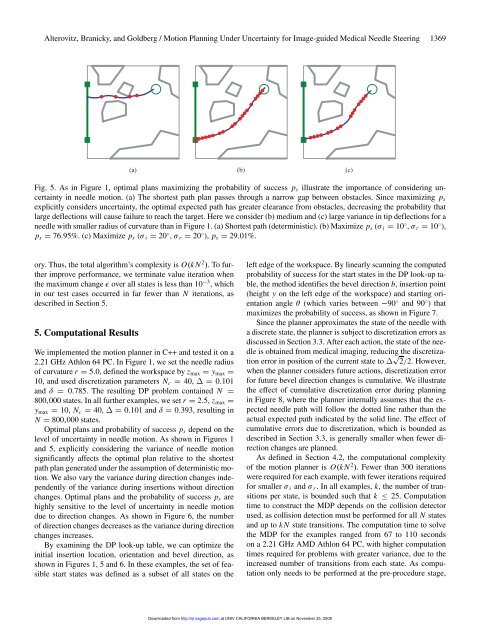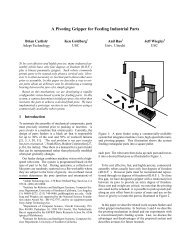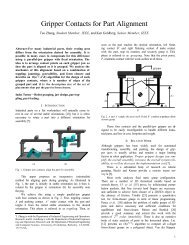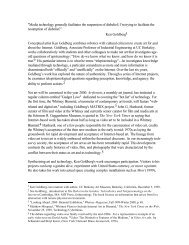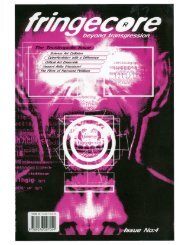0.5MB .pdf - Ken Goldberg - University of California, Berkeley
0.5MB .pdf - Ken Goldberg - University of California, Berkeley
0.5MB .pdf - Ken Goldberg - University of California, Berkeley
You also want an ePaper? Increase the reach of your titles
YUMPU automatically turns print PDFs into web optimized ePapers that Google loves.
Alterovitz, Branicky, and <strong>Goldberg</strong> / Motion Planning Under Uncertainty for Image-guided Medical Needle Steering 1369<br />
Fig. 5. As in Figure 1, optimal plans maximizing the probability <strong>of</strong> success ps illustrate the importance <strong>of</strong> considering uncertainty<br />
in needle motion. (a) The shortest path plan passes through a narrow gap between obstacles. Since maximizing ps<br />
explicitly considers uncertainty, the optimal expected path has greater clearance from obstacles, decreasing the probability that<br />
large deflections will cause failure to reach the target. Here we consider (b) medium and (c) large variance in tip deflections for a<br />
needle with smaller radius <strong>of</strong> curvature than in Figure 1. (a) Shortest path (deterministic). (b) Maximize ps ( i 10 , r 10 ),<br />
ps 7695%. (c) Maximize ps ( i 20 , r 20 ), ps 2901%.<br />
ory. Thus, the total algorithm’s complexity is OkN 2 .T<strong>of</strong>urther<br />
improve performance, we terminate value iteration when<br />
the maximum change overallstatesislessthan10 3 ,which<br />
in our test cases occurred in far fewer than N iterations, as<br />
described in Section 5.<br />
5. Computational Results<br />
We implemented the motion planner in C++ and tested it on a<br />
2.21 GHz Athlon 64 PC. In Figure 1, we set the needle radius<br />
<strong>of</strong> curvature r 50, defined the workspace by zmax ymax <br />
10, and used discretization parameters Nc 40, 0101<br />
and 0785. The resulting DP problem contained N <br />
800000 states. In all further examples, we set r 25, zmax <br />
ymax 10, Nc 40, 0101 and 0393, resulting in<br />
N 800000 states.<br />
Optimal plans and probability <strong>of</strong> success ps depend on the<br />
level <strong>of</strong> uncertainty in needle motion. As shown in Figures 1<br />
and 5, explicitly considering the variance <strong>of</strong> needle motion<br />
significantly affects the optimal plan relative to the shortest<br />
path plan generated under the assumption <strong>of</strong> deterministic motion.<br />
We also vary the variance during direction changes independently<br />
<strong>of</strong> the variance during insertions without direction<br />
changes. Optimal plans and the probability <strong>of</strong> success ps are<br />
highly sensitive to the level <strong>of</strong> uncertainty in needle motion<br />
due to direction changes. As shown in Figure 6, the number<br />
<strong>of</strong> direction changes decreases as the variance during direction<br />
changes increases.<br />
By examining the DP look-up table, we can optimize the<br />
initial insertion location, orientation and bevel direction, as<br />
shown in Figures 1, 5 and 6. In these examples, the set <strong>of</strong> feasible<br />
start states was defined as a subset <strong>of</strong> all states on the<br />
Downloaded from<br />
http://ijr.sagepub.com at UNIV CALIFORNIA BERKELEY LIB on November 25, 2008<br />
left edge <strong>of</strong> the workspace. By linearly scanning the computed<br />
probability <strong>of</strong> success for the start states in the DP look-up table,<br />
the method identifies the bevel direction b, insertion point<br />
(height y on the left edge <strong>of</strong> the workspace) and starting orientation<br />
angle (which varies between 90 and 90 )that<br />
maximizes the probability <strong>of</strong> success, as shown in Figure 7.<br />
Since the planner approximates the state <strong>of</strong> the needle with<br />
a discrete state, the planner is subject to discretization errors as<br />
discussed in Section 3.3. After each action, the state <strong>of</strong> the needle<br />
is obtained from medical imaging, reducing the discretization<br />
error in position <strong>of</strong> the current state to 22. However,<br />
when the planner considers future actions, discretization error<br />
for future bevel direction changes is cumulative. We illustrate<br />
the effect <strong>of</strong> cumulative discretization error during planning<br />
in Figure 8, where the planner internally assumes that the expected<br />
needle path will follow the dotted line rather than the<br />
actual expected path indicated by the solid line. The effect <strong>of</strong><br />
cumulative errors due to discretization, which is bounded as<br />
described in Section 3.3, is generally smaller when fewer direction<br />
changes are planned.<br />
As defined in Section 4.2, the computational complexity<br />
<strong>of</strong> the motion planner is OkN 2 . Fewer than 300 iterations<br />
were required for each example, with fewer iterations required<br />
for smaller i and r. In all examples, k, the number <strong>of</strong> transitions<br />
per state, is bounded such that k 25. Computation<br />
time to construct the MDP depends on the collision detector<br />
used, as collision detection must be performed for all N states<br />
and up to kN state transitions. The computation time to solve<br />
the MDP for the examples ranged from 67 to 110 seconds<br />
on a 2.21 GHz AMD Athlon 64 PC, with higher computation<br />
times required for problems with greater variance, due to the<br />
increased number <strong>of</strong> transitions from each state. As computation<br />
only needs to be performed at the pre-procedure stage,


